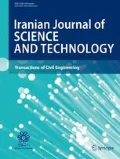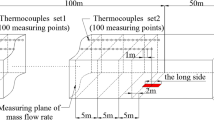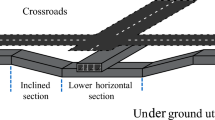Abstract
Fire fighting in the highway tunnel has been the main threat to the tunnel operation safety. In the present study, a small-scale tunnel model has been established based on Caihongling Tunnel in Jiangmen at China and 24 sets of small-scaled fire model tests have been carried out with tunnel slope gradient, ventilation velocity and fire power as main factors. The slope takes gradient of 0.0%, 1.5% and 3.0%, respectively, and the ventilation velocity is successively set at 0 m/s, 0.3 m/s, 0.6 m/s and 0.9 m/s. Furthermore, the fire power, based on pool fire, is classified as type A and B. As a result of the error of measurement and the influence of environmental factors, the fire source power for type A is set to 17.2 kW and 22 kW for type B. In view of the tests, the present study investigates the smoke flow and longitudinal distribution of temperature along the highway tunnel, with an aim to analyze the range and direction of smoke flow under different operating conditions and further reveal the law of longitudinal distribution of temperature at different levels. According to the test results, it is hoped that the present study can provide some basis and insight for the tunnel structure, fire protection of equipment and the setting of ventilation velocity and evacuation in the case of fire.

















Similar content being viewed by others
References
Atkinson G, Wu Y (1996) Smoke control in sloping tunnels. Fire Saf J 27(4):335–341
Chen L (2013) Studies on buoyancy driven two-directional smoke flow layering length with combination of point extraction and longitudinal ventilation in tunnel fires. Fire Saf J 59(7):94–101
Cheng J, Mei J, Peng S, Qi C, Shi Y (2019) Comprehensive consultation model for explosion risk in mine atmosphere-CCMER. Saf Sci 120:798–812
China MOCO (2004) Code for design of highway tunnel, People's Republic of China industry standard, in JTGD70-2004. People Communications Press, Bei Jing
China Traffic News Network (2019) https://www.zgjtb.com. Accessed June 10 2019
Gannouni S, Maad RB (2015) Numerical study of the effect of blockage on critical velocity and backlayering length in longitudinally ventilated tunnel fires. Tunnel Undergr Sp Technol 48(8):147–155
Garlock M, Ignacio P (2012) Fire hazard in bridges: review, assessment and repair strategies. Eng Struct 35(1):89–98
Hua G, Wang W, Zhao Y (2011) A study of an optimal smoke control strategy for an urban traffic link tunnel fire. Tunn Undergr Sp Technol 26(2):336–344
Ingason H, Li Y (2010) Model scale tunnel fire tests with longitudinal ventilation. Fire Saf J 45:371–384
Ingason H, Li Y (2011) Model scale tunnel fire tests with point extraction ventilation. J Fire Prot Eng 21(1):5–36
Ji J, Zhong W, Shen X (2011) A simplified calculation method on maximum smoke temperature under the ceiling in subway station fires. Tunnel Undergr Sp Technol 26(3):490–496
Ko Y, Hadjisophocleous G (2013) Study of smoke backlayering during suppression in tunnels. Fire Saf J 58(2):240–247
Lai J (2017) Statistical analysis of fire accidents in highway tunnels and countermeasures for disaster prevention and reduction. Tunnel Constr 37:409–415
Li Y (2010) Maximum ceiling temperature in a tunnel fire. SP report
Li Y, Lei B, Ingason H (2011) The maximum temperature of buoyancy-driven smoke flow beneath the ceiling in tunnel fires. Fire Saf J 46(4):204–210
Minehiro T (2012) Backlayering distance of thermal fumes in tunnel fire experiments using a large-scale model. JFST 7(3):389–404
Opstad K, Aune P, Henning J (1997) Fire emergency ventilation capacity for road tunnels with considerable slope. In: 9th international symposium on aerodynamics and ventilation of vehicle tunnels—developments for the 21st-century AOSTA, Italy
Qiang J, Zhu H (2006) Discussion on the cause of tunnel fire and its preventive measures. In: 12th annual conference of the Chinese civil engineering society and the 14th annual meeting of the tunnel and underground engineering branch
The road tunnels manual, 2019.6.26, https://tunnels.piarc.org/en/introduction/road-tunnels-manual
Wang Z (2012) Fire hazard and countermeasures of subbottom tunnel. Fire Sci Technol 31(6):608–611
World Road Association (2019) Design fire characteristics of road tunnels Technical Committee 3.3 Road Tunnels Operations, CEDEX, France, ISBN 978-2-84060-417-6
Wu D, Xu Z, Li W (2013) Fire smoke control in highway tunnel: study on smoke exhaust system of independent flue duct. China Communication Press, Beijing
Yan Z, Yang X, Zhu H (2005) Experimental study on fire of Qinling Mountains extra-long highway tunnel. China Civ Eng J 38(11):96–101
Zeng L, Wang S, Lin Z (2012) Investigation and analysis of fire accidents in highway tunnels. Mod Tunn Technol 49(3):41–48
Zhang Y, Ma H (2005) Analysis of fire control problems of Qinling Mountains Nanshan extra long highway tunnel. Fire Sci Technol 24(5):577–580
Zhong Y, Lei B, Kashef A (2013) Reduced-scale experimental research on fires in tunnels with natural ventilation. Proc Eng 62(6):907–915
Acknowledgements
This work is financially supported by grant from the Fundamental Research Funds for the Central Universities (Grant No. 2015XKMS007). The authors are grateful for the support.
Author information
Authors and Affiliations
Corresponding author
Rights and permissions
About this article
Cite this article
Cheng, J., Wang, Z., Liu, F. et al. Inclination Effects on Temperature Distribution of Fire Smoke for Highway Tunnel. Iran J Sci Technol Trans Civ Eng 45, 2817–2830 (2021). https://doi.org/10.1007/s40996-020-00452-3
Received:
Accepted:
Published:
Issue Date:
DOI: https://doi.org/10.1007/s40996-020-00452-3




